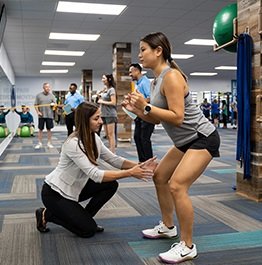
5 Safety Tips To Avoid Injury At The Gym
February 14, 2017Does your New Year’s Resolution consist of going back to the gym to get fit for 2017? Your fitness level depends on getting regular exercise, but how you approach a workout program will determine whether it enhances your physique or actually lead you to possible injury.
No one plans on getting injured when they go to work out. Still, most people tend to do just that at least once in their journey to a better physique.
Check out these 5 steps for a safer workout and more fun in the gym.
1. WEIGHT TRAINING THROUGH FULL RANGE OF MOTION
For strength training, good form is essential. Using good form not only helps you to maximize your strength gains, but it helps prevent some serious injuries. Initially, use very light weights when learning a new exercise. Never sacrifice good form by struggling to lift heavier weights. More importantly, never sacrifice good form by hurrying to finish reps or sets leading to modified range of motion.
Take the time to learn control and feel the work in your muscles. This includes avoiding any type of bouncing, jerking or partial moves forced by necessity. In other words, if you stop halfway down when performing a biceps curl because you would not be able to curl up may indicate fatigue from using too much weight.
Perform each exercise in full available range of motion at a reasonable pace to decrease stress and possible injury to your joints and soft tissue structures.
2. BODY MECHANICS ON CARDIO MACHINES
- Do not hold onto the top of the treadmill when walking at an incline:
The concept of walking at an incline is to increase your cardiovascular endurance in a given amount of time the activity is being performed. The mechanics places your body at an acute angle with the treadmill increasing your energy expenditure. However, when holding onto the top and thus leaning backwards, you place your body closed to a 90 deg. Angle with the treadmill – in turn, the same angle as if you were walking on a flat ground.
- Do not lean heavily on the “Stair Master” rails:
Leaning heavily on the rails will put a lot of unnecessary weight on your wrists, shoulders and back leading to possible injury. The need to lean is a sign of fatigue and your body’s way to use accessory breathing muscles of the neck and rib cage for further rib expansion. The overuse of these muscles can lead to neck stiffness from muscle tightness and pain.
3. STAY HYDRATED
Simply drink plenty of water! Make sure you are replacing the fluids that you are losing through sweat during your workout. Drinking water will help reduce your chances of becoming dehydrated, which can lead to poor performance. A good rule of thumb includes the following:
- Drink 2 cups (16 ounces) of water about 15 minutes prior to activity
- A quick sip every 10 to 20 minutes during activity
- Another 16 ounces post activity during your cool down
4. STRETCHING IS AN EXERCISE TOO!
Failure to stretch will make your muscles tight and eventually shorten over time, making you less flexible. While it may seem like a minor detail, your muscles and joints become a lot more vulnerable to injury by interfering with the normal mechanics of the exercise. Not a big deal at first, but over time if you train “wrong,” you will be placing a lot of extra stress on joints, ligaments and unintended secondary muscle groups due to compensations.
In a nutshell, do not be so eager to hit the weights and skip out on or ignore stretching altogether.
This is a HUGE MISTAKE!!!
Proper stretching can be included during your warm-up or cool down. Your warm-up shoulder focus on raising your core temperature, getting your metabolism into gear and “pre-lubricating” the joints in preparation for the actual workout. Furthermore, stretching can be helpful during the cool down phase to flush out lactic acid and byproducts while bringing in fresh nutrients helping your muscles recover faster.
So do yourself a favor and take 5 to 10 minutes to warm-up and cool down properly. A proper warm-up and cool-down should include:
- 5-10 mins of moderate cardio on a treadmill or stationary bike
- 5 minutes of light stretching
5. ADD VARIETY TO YOUR ROUTINE
“Too much of a good thing” should not be the motto of your workout. Overuse injuries are very common when you perform the same type of exercise over and over again. For example, swimmers place a lot of repetitive stress on their shoulders, while runners pound away at this knees, ankles and feet.
Not only will you make yourself prone to injury with a repetitive routine, but your body will begin to adapt when you do only one type of exercise. This type of body adaption decreases the benefit from the workout, thus not giving you the results that you are looking for.
The best exercise programs involve a mixture of aerobic (cardio) activity and strength training, along with stretching. Always vary your aerobic activity to keep it interesting and to decrease overuse injuries. Such activities can included, swimming, riding a bike, brisk walking, playing basketball, dance classes, etc.
Additionally, always take off at least one day between strength training sessions to allow your muscles to recover. A few routine examples are as follows:
| SUNDAY | MONDAY | TUESDAY | WEDNESDAY | THURSDAY | FRIDAY | SATURDAY | |
| Example 1 | Rest | 30 mins on the bike | Arm strengthening | 30 mins walking/running | Rest | Leg strengthening | Outdoor activity |
| Example 2 | Rest | 30 mins. Walking/running | 30 mins rowing
Arm strengthening |
Rest | 60 mins workout class | Rest | Leg strengthening |
Sign up for a FREE Assessment with CBPT!
Don’t let pain prevent you from enjoying the gym, sign up for a free assessment today!
Reader Interactions
Leave a comment
You must be logged in to post a comment.





